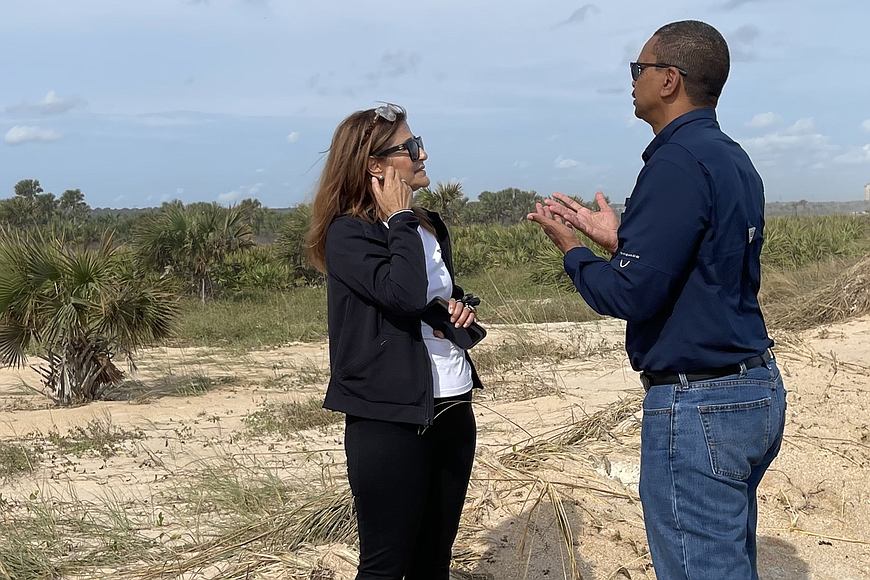- April 23, 2024
-
-
Loading

Loading

There are few things that Flagler County residents cherish more than its beaches.
Years of hurricanes, high-tides and storms have eroded most, if not all, of the shoreline’s protective dunes. But County Engineer Faith Alkhatib has managed to secure good news for the county’s shoreline:
In January 2023, Alkhatib hopes to begin the renourishment project from Hurricane Dorian, a project over three years in the works. She has managed to finagle around $12.6 million in total for six miles of shoreline.
“It takes time,” Alkhatib said, “but we’re on the right track.”
Here’s the crux of the issues: before Hurricane Matthew, the beaches were not engineered, and ergo did not qualify for certain federal funding, Alkhatib said. Post-Matthew, the damaged shoreline was somewhat fixed, becoming engineered beaches and thus eligible for other funding in the future.
Hurricane Dorian lost the county around 50,000 cubic yards of sand, Alkhatib said. Because of federal funding requirements, FEMA can only replace what was lost during a storm — in the case of Dorian, the 50,000 cubic yards of sand, over the course of six miles of shoreline.
The problem is that the dunes were never built back up to pre-Matthew heights, and sand is expensive, ranging from $63-$70 per cubic yard.
So that 50,000 cubic yards over six miles would equate to 1.5 cubic yards per foot, Alkhatib said. After almost four years of additional erosion, that amount would not provide any protection.
“For protection,the criteria or the rule of thumb we use is six cubic yards-per-foot.” — County Engineer Faith Alkhatib
“For protection,” she said, “the criteria or the rule of thumb we use is six cubic yards-per-foot.”
Instead of stretching the 50,000 cubic yards of sand over the six miles, Alkhatib said she would focus on building as much of one area up to the six cubic yard/foot criteria as possible. That 50,000 then translates over 1.5 miles of that measurement.
Alkhatib also received news of two additional sources of funding. The county had $3.8 million of emergency funding left over from Hurricane Matthew that she could add to the Dorian renourishment, and on Dec. 5 the county also received $5 million in emergency sand funds from the Florida Department of Environmental Protection.
With local funding constraints, Alkhatib needed to remove the 50% local cost match for the $3.8 million — which she did by moving the site to Gamble Rogers Memorial State Recreation Area. By moving it to a regional interest that also needs repairs, FEMA waived the match requirement; Alkhatib saved the county around $1.9 million and almost doubled the amount of ground the Dorian project could cover.
The $5 million in emergency sand funding from FDEP will be split across projects up and down the shoreline, Alkhatib said. But with the three sets of funding together, she said will be able to cover almost the full original six miles of the Dorian project in the six cubic yards/foot of sand.
It is still a temporary fix, she said, but one that must be done before more erosion happens in the next storm.
Jason Harrah, senior project manager with the Army Corps of Engineers, said that the six cubic yard/foot standard might not seem like much, but it protects against 5–10-year storm events. And even after it washes away, the smaller, temporary fixes still help build up against erosion.
The cubic yards-per-foot measurement, Harrah said, is how they measure the still density.
“Think of it like a birthday cake,” Harrah said. “You're basically adding more layers of icing on top protecting that inner layer.”
The washed away sand won't disappear into the ocean, Harrah said, but instead builds up the sand sitting in ankle deep water on the beach.
The Army Corps of Engineers build their projects out for 100-year storm events, Harrah said. Whenever the last easement is acquired, their current project in Flagler County will build up that stretch of land to 75 cubic yards/foot, or 19 feet in height.
That will bring that 2.6-mile stretch around Flagler Beach up to pre-Matthew standards.
And, because of the study agreement between Flagler County and the Army Corps of Engineers, Harrah said the Corps will come out every 11 years to check on the area and would pay 100% of the repair costs after storms damage them.
On top of that, once this section is finished, because of the 2002 study the Corps did for the 2.6-mile erosion project, they can come back and reevaluate other areas of Flagler County’s shoreline, Harrah said.
If another stretch is damaged enough and meets other criteria, the Corps could return to shore up another section of shoreline, Harrah said.
But the longer projects take to begin, the more it will cost — in both time and money. In 2014 when the study was completed, 2.6-miles needed 330,000 cubic yards of sand. Now, Harrah said, the area needs 1.3 million.
Alkhatib made the same point. The longer the county takes to rebuild the dunes and beaches, the more sand it will take to get the dunes just to the six cubic yard/ft minimum. For the Army Corp project, if the work doesn't start by May of 2023, she said, it maybe delayed until after the next hurricane season.
"We need the public to help us so we can help," Alkhatib said. "To give us easements, to work with us."